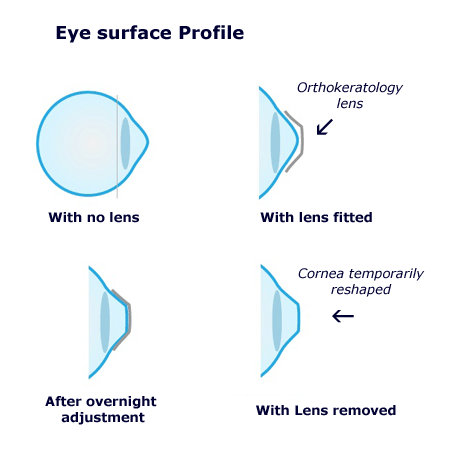Orthokeratology or Corneal Reshaping
Orthokeratology or Corneal Reshaping are contact lenses specially designed to treat Myopia; the symptoms of which can by marked by "nearsightedness" or blurred vision at a distance. Causes of Myopia range anywhere from genetics to environmental. The effects can lead to headaches, or higher risks such as retinal tears, breaks, or detachments along with increased incidence of early cataracts, posterior vitreous detachments and/or Glaucoma if untreated. Glasses or daily contact wear make images clear but do not prevent Myopia Progression.
What is Orthokeratology?
Orthokeratology is overnight rigid contact lens wear that allows you to wakeup with clear vision without glasses or other contact lens wear. The goal of this treatment is to prevent myopia progression while providing clear, crisp vision throughout the day by temporary corneal reshaping.
How does it work?
The rigid contact lenses are put in before you go to sleep and work overnight. The lens' rigid nature works to "reshape" the cornea (the front surface of the eye) resulting in clear central vision while peripheral light rays are redirected to slow/prevent eye elongation which causes Myopia. This result is temporary, meaning that if the overnight application is stopped, vision and prescription will return to the starting point. Consistency is key!
What can I expect during consultation and follow up visits?
Patient must have a complete exam with refraction within the last three months; if not, an up-to-date refraction will be performed at the consultation to determine if the patient will be a good candidate.
The initial consultation will include corneal mapping and ocular measurements including corneal curvature and diameters, tear layer evaluation and pupil evaluation. Once lenses have arrived, practitioner will insert the lens. A thorough lens evaluation will follow including patient education on proper lens insertion and removal, as well as handling and care.
Frequent follow-up visits are required. At minimum, patient will be seen after first week, first month, 3 months, 6 months and after 1 year of wear.



